ElectroServe PLC: Evaluation of Proposed Investment (BFK450)
VerifiedAdded on 2023/01/16
|6
|1777
|77
Report
AI Summary
This report evaluates ElectroServe PLC's proposed investment in a new artificially intelligent robot model ('Model 2'). The analysis employs three investment appraisal methods: payback period, net present value (NPV), and internal rate of return (IRR). The report details the financial evaluation, including estimated sales, costs, and cash flows over five years. It calculates the payback period (approximately 1 year 4 months), NPV ($2,111,007), and IRR (104%), concluding the project is financially viable. Scenario analysis, considering 20% increases and decreases in sales volume, further supports this conclusion. The report also outlines supporting documentation such as costs of raw materials, revenue from sales, and factory space costs. Key limitations and qualitative aspects, such as market availability and alignment with company objectives, are discussed, and a recommendation to the Board of Directors is provided. The analysis is based on assumptions like cash transactions and a 11% discount rate.
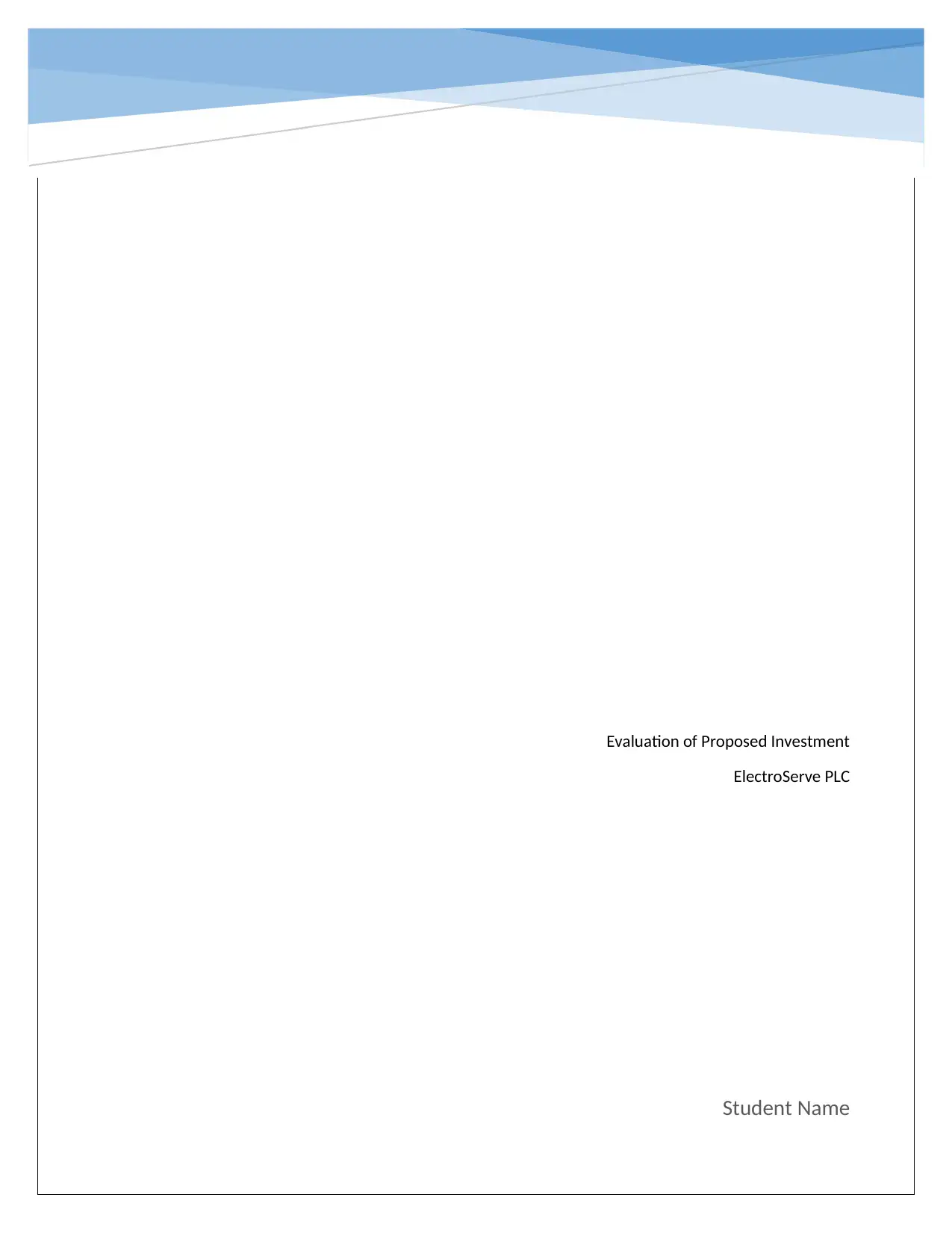
Evaluation of Proposed Investment
ElectroServe PLC
Student Name
ElectroServe PLC
Student Name
Paraphrase This Document
Need a fresh take? Get an instant paraphrase of this document with our AI Paraphraser
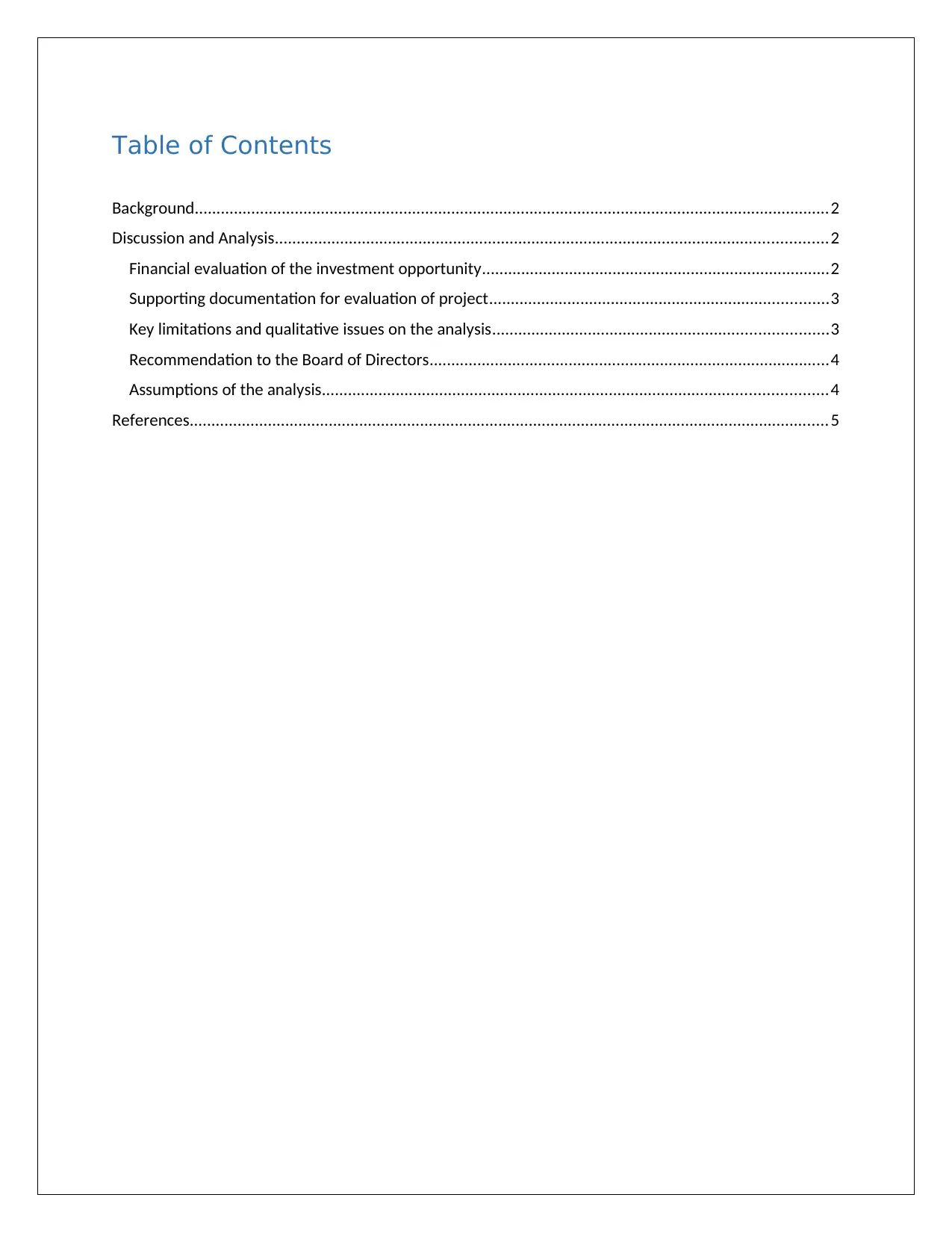
Table of Contents
Background..................................................................................................................................................2
Discussion and Analysis...............................................................................................................................2
Financial evaluation of the investment opportunity................................................................................2
Supporting documentation for evaluation of project..............................................................................3
Key limitations and qualitative issues on the analysis.............................................................................3
Recommendation to the Board of Directors............................................................................................4
Assumptions of the analysis....................................................................................................................4
References...................................................................................................................................................5
Background..................................................................................................................................................2
Discussion and Analysis...............................................................................................................................2
Financial evaluation of the investment opportunity................................................................................2
Supporting documentation for evaluation of project..............................................................................3
Key limitations and qualitative issues on the analysis.............................................................................3
Recommendation to the Board of Directors............................................................................................4
Assumptions of the analysis....................................................................................................................4
References...................................................................................................................................................5
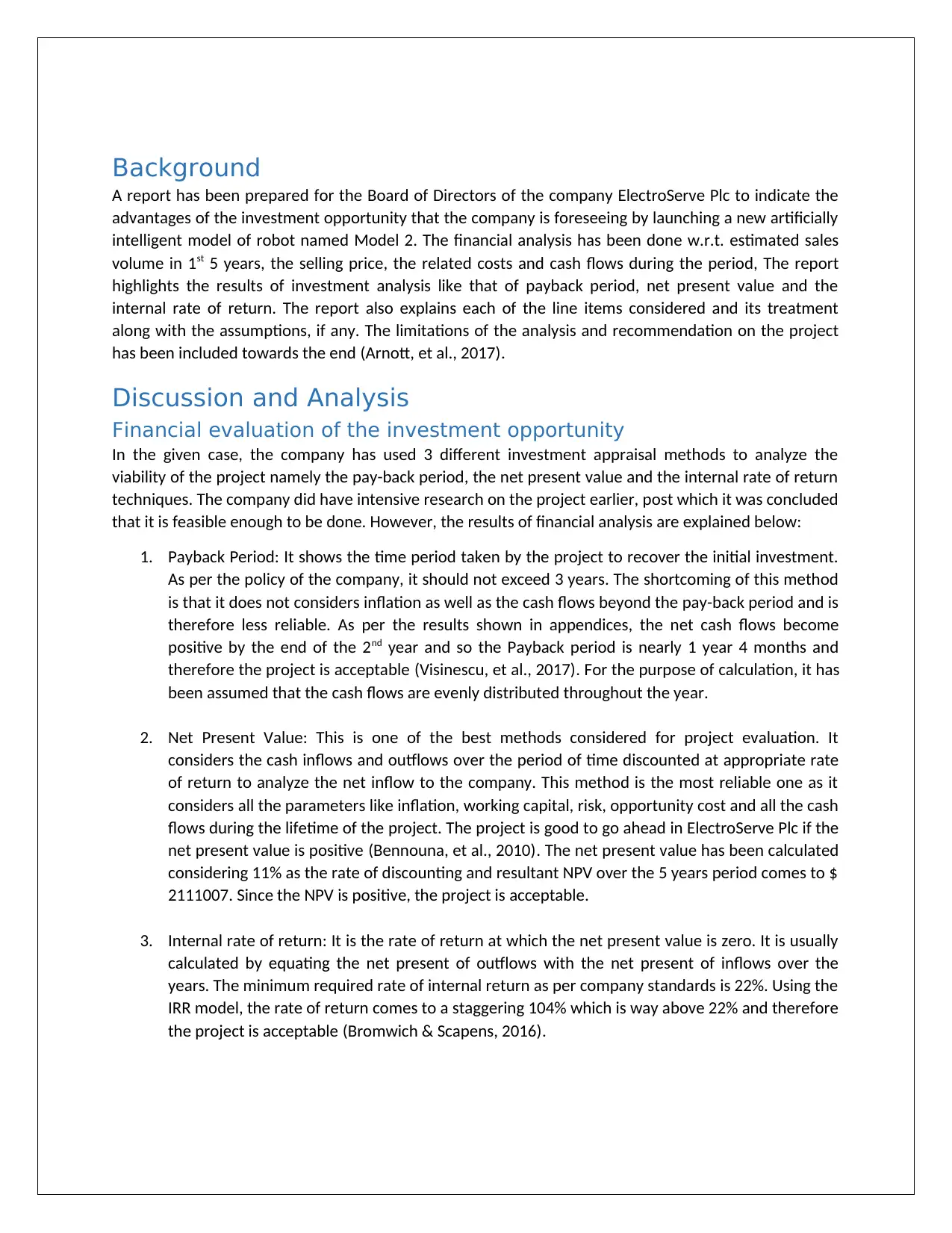
Background
A report has been prepared for the Board of Directors of the company ElectroServe Plc to indicate the
advantages of the investment opportunity that the company is foreseeing by launching a new artificially
intelligent model of robot named Model 2. The financial analysis has been done w.r.t. estimated sales
volume in 1st 5 years, the selling price, the related costs and cash flows during the period, The report
highlights the results of investment analysis like that of payback period, net present value and the
internal rate of return. The report also explains each of the line items considered and its treatment
along with the assumptions, if any. The limitations of the analysis and recommendation on the project
has been included towards the end (Arnott, et al., 2017).
Discussion and Analysis
Financial evaluation of the investment opportunity
In the given case, the company has used 3 different investment appraisal methods to analyze the
viability of the project namely the pay-back period, the net present value and the internal rate of return
techniques. The company did have intensive research on the project earlier, post which it was concluded
that it is feasible enough to be done. However, the results of financial analysis are explained below:
1. Payback Period: It shows the time period taken by the project to recover the initial investment.
As per the policy of the company, it should not exceed 3 years. The shortcoming of this method
is that it does not considers inflation as well as the cash flows beyond the pay-back period and is
therefore less reliable. As per the results shown in appendices, the net cash flows become
positive by the end of the 2nd year and so the Payback period is nearly 1 year 4 months and
therefore the project is acceptable (Visinescu, et al., 2017). For the purpose of calculation, it has
been assumed that the cash flows are evenly distributed throughout the year.
2. Net Present Value: This is one of the best methods considered for project evaluation. It
considers the cash inflows and outflows over the period of time discounted at appropriate rate
of return to analyze the net inflow to the company. This method is the most reliable one as it
considers all the parameters like inflation, working capital, risk, opportunity cost and all the cash
flows during the lifetime of the project. The project is good to go ahead in ElectroServe Plc if the
net present value is positive (Bennouna, et al., 2010). The net present value has been calculated
considering 11% as the rate of discounting and resultant NPV over the 5 years period comes to $
2111007. Since the NPV is positive, the project is acceptable.
3. Internal rate of return: It is the rate of return at which the net present value is zero. It is usually
calculated by equating the net present of outflows with the net present of inflows over the
years. The minimum required rate of internal return as per company standards is 22%. Using the
IRR model, the rate of return comes to a staggering 104% which is way above 22% and therefore
the project is acceptable (Bromwich & Scapens, 2016).
A report has been prepared for the Board of Directors of the company ElectroServe Plc to indicate the
advantages of the investment opportunity that the company is foreseeing by launching a new artificially
intelligent model of robot named Model 2. The financial analysis has been done w.r.t. estimated sales
volume in 1st 5 years, the selling price, the related costs and cash flows during the period, The report
highlights the results of investment analysis like that of payback period, net present value and the
internal rate of return. The report also explains each of the line items considered and its treatment
along with the assumptions, if any. The limitations of the analysis and recommendation on the project
has been included towards the end (Arnott, et al., 2017).
Discussion and Analysis
Financial evaluation of the investment opportunity
In the given case, the company has used 3 different investment appraisal methods to analyze the
viability of the project namely the pay-back period, the net present value and the internal rate of return
techniques. The company did have intensive research on the project earlier, post which it was concluded
that it is feasible enough to be done. However, the results of financial analysis are explained below:
1. Payback Period: It shows the time period taken by the project to recover the initial investment.
As per the policy of the company, it should not exceed 3 years. The shortcoming of this method
is that it does not considers inflation as well as the cash flows beyond the pay-back period and is
therefore less reliable. As per the results shown in appendices, the net cash flows become
positive by the end of the 2nd year and so the Payback period is nearly 1 year 4 months and
therefore the project is acceptable (Visinescu, et al., 2017). For the purpose of calculation, it has
been assumed that the cash flows are evenly distributed throughout the year.
2. Net Present Value: This is one of the best methods considered for project evaluation. It
considers the cash inflows and outflows over the period of time discounted at appropriate rate
of return to analyze the net inflow to the company. This method is the most reliable one as it
considers all the parameters like inflation, working capital, risk, opportunity cost and all the cash
flows during the lifetime of the project. The project is good to go ahead in ElectroServe Plc if the
net present value is positive (Bennouna, et al., 2010). The net present value has been calculated
considering 11% as the rate of discounting and resultant NPV over the 5 years period comes to $
2111007. Since the NPV is positive, the project is acceptable.
3. Internal rate of return: It is the rate of return at which the net present value is zero. It is usually
calculated by equating the net present of outflows with the net present of inflows over the
years. The minimum required rate of internal return as per company standards is 22%. Using the
IRR model, the rate of return comes to a staggering 104% which is way above 22% and therefore
the project is acceptable (Bromwich & Scapens, 2016).
⊘ This is a preview!⊘
Do you want full access?
Subscribe today to unlock all pages.

Trusted by 1+ million students worldwide
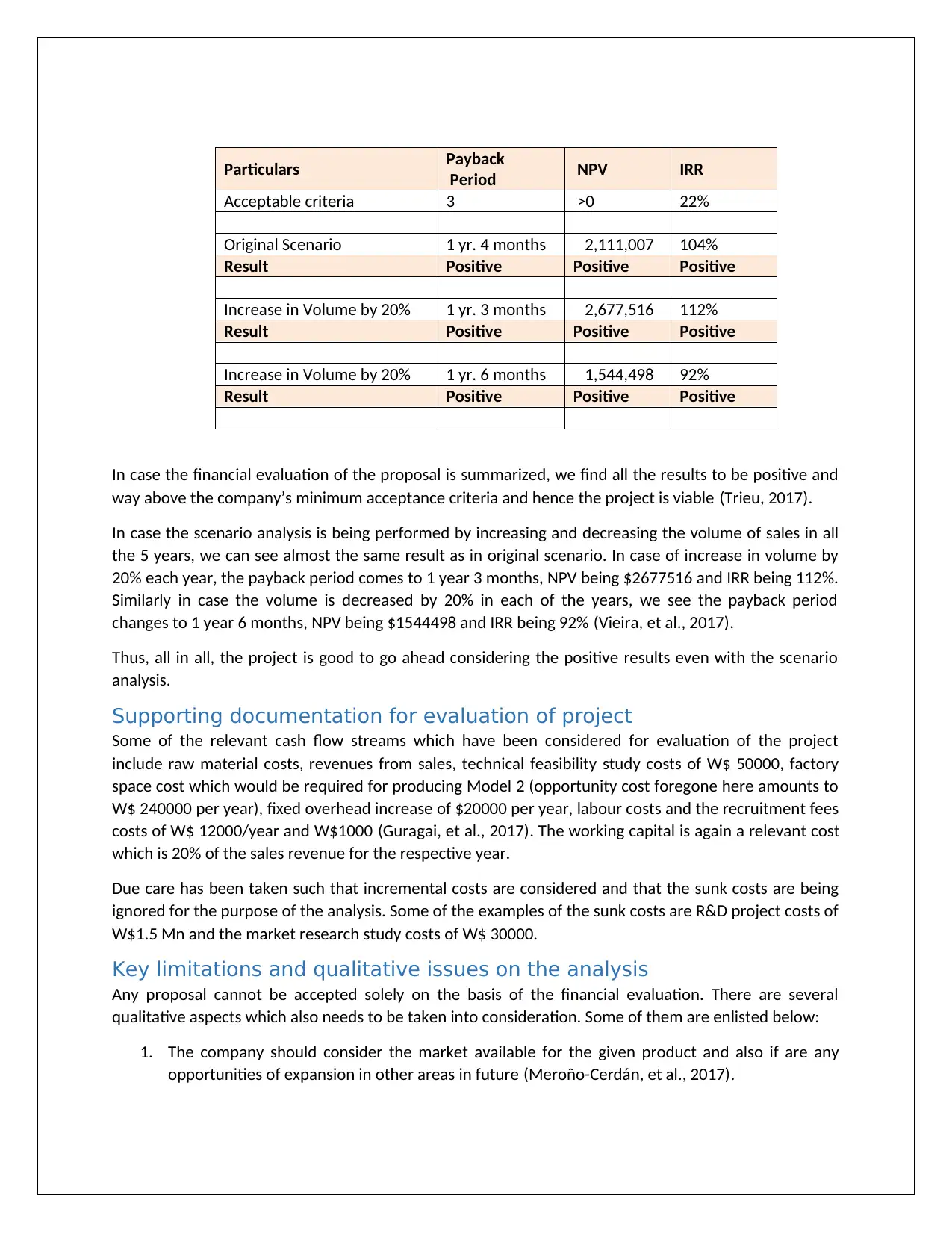
Particulars Payback
Period NPV IRR
Acceptable criteria 3 >0 22%
Original Scenario 1 yr. 4 months 2,111,007 104%
Result Positive Positive Positive
Increase in Volume by 20% 1 yr. 3 months 2,677,516 112%
Result Positive Positive Positive
Increase in Volume by 20% 1 yr. 6 months 1,544,498 92%
Result Positive Positive Positive
In case the financial evaluation of the proposal is summarized, we find all the results to be positive and
way above the company’s minimum acceptance criteria and hence the project is viable (Trieu, 2017).
In case the scenario analysis is being performed by increasing and decreasing the volume of sales in all
the 5 years, we can see almost the same result as in original scenario. In case of increase in volume by
20% each year, the payback period comes to 1 year 3 months, NPV being $2677516 and IRR being 112%.
Similarly in case the volume is decreased by 20% in each of the years, we see the payback period
changes to 1 year 6 months, NPV being $1544498 and IRR being 92% (Vieira, et al., 2017).
Thus, all in all, the project is good to go ahead considering the positive results even with the scenario
analysis.
Supporting documentation for evaluation of project
Some of the relevant cash flow streams which have been considered for evaluation of the project
include raw material costs, revenues from sales, technical feasibility study costs of W$ 50000, factory
space cost which would be required for producing Model 2 (opportunity cost foregone here amounts to
W$ 240000 per year), fixed overhead increase of $20000 per year, labour costs and the recruitment fees
costs of W$ 12000/year and W$1000 (Guragai, et al., 2017). The working capital is again a relevant cost
which is 20% of the sales revenue for the respective year.
Due care has been taken such that incremental costs are considered and that the sunk costs are being
ignored for the purpose of the analysis. Some of the examples of the sunk costs are R&D project costs of
W$1.5 Mn and the market research study costs of W$ 30000.
Key limitations and qualitative issues on the analysis
Any proposal cannot be accepted solely on the basis of the financial evaluation. There are several
qualitative aspects which also needs to be taken into consideration. Some of them are enlisted below:
1. The company should consider the market available for the given product and also if are any
opportunities of expansion in other areas in future (Meroño-Cerdán, et al., 2017).
Period NPV IRR
Acceptable criteria 3 >0 22%
Original Scenario 1 yr. 4 months 2,111,007 104%
Result Positive Positive Positive
Increase in Volume by 20% 1 yr. 3 months 2,677,516 112%
Result Positive Positive Positive
Increase in Volume by 20% 1 yr. 6 months 1,544,498 92%
Result Positive Positive Positive
In case the financial evaluation of the proposal is summarized, we find all the results to be positive and
way above the company’s minimum acceptance criteria and hence the project is viable (Trieu, 2017).
In case the scenario analysis is being performed by increasing and decreasing the volume of sales in all
the 5 years, we can see almost the same result as in original scenario. In case of increase in volume by
20% each year, the payback period comes to 1 year 3 months, NPV being $2677516 and IRR being 112%.
Similarly in case the volume is decreased by 20% in each of the years, we see the payback period
changes to 1 year 6 months, NPV being $1544498 and IRR being 92% (Vieira, et al., 2017).
Thus, all in all, the project is good to go ahead considering the positive results even with the scenario
analysis.
Supporting documentation for evaluation of project
Some of the relevant cash flow streams which have been considered for evaluation of the project
include raw material costs, revenues from sales, technical feasibility study costs of W$ 50000, factory
space cost which would be required for producing Model 2 (opportunity cost foregone here amounts to
W$ 240000 per year), fixed overhead increase of $20000 per year, labour costs and the recruitment fees
costs of W$ 12000/year and W$1000 (Guragai, et al., 2017). The working capital is again a relevant cost
which is 20% of the sales revenue for the respective year.
Due care has been taken such that incremental costs are considered and that the sunk costs are being
ignored for the purpose of the analysis. Some of the examples of the sunk costs are R&D project costs of
W$1.5 Mn and the market research study costs of W$ 30000.
Key limitations and qualitative issues on the analysis
Any proposal cannot be accepted solely on the basis of the financial evaluation. There are several
qualitative aspects which also needs to be taken into consideration. Some of them are enlisted below:
1. The company should consider the market available for the given product and also if are any
opportunities of expansion in other areas in future (Meroño-Cerdán, et al., 2017).
Paraphrase This Document
Need a fresh take? Get an instant paraphrase of this document with our AI Paraphraser
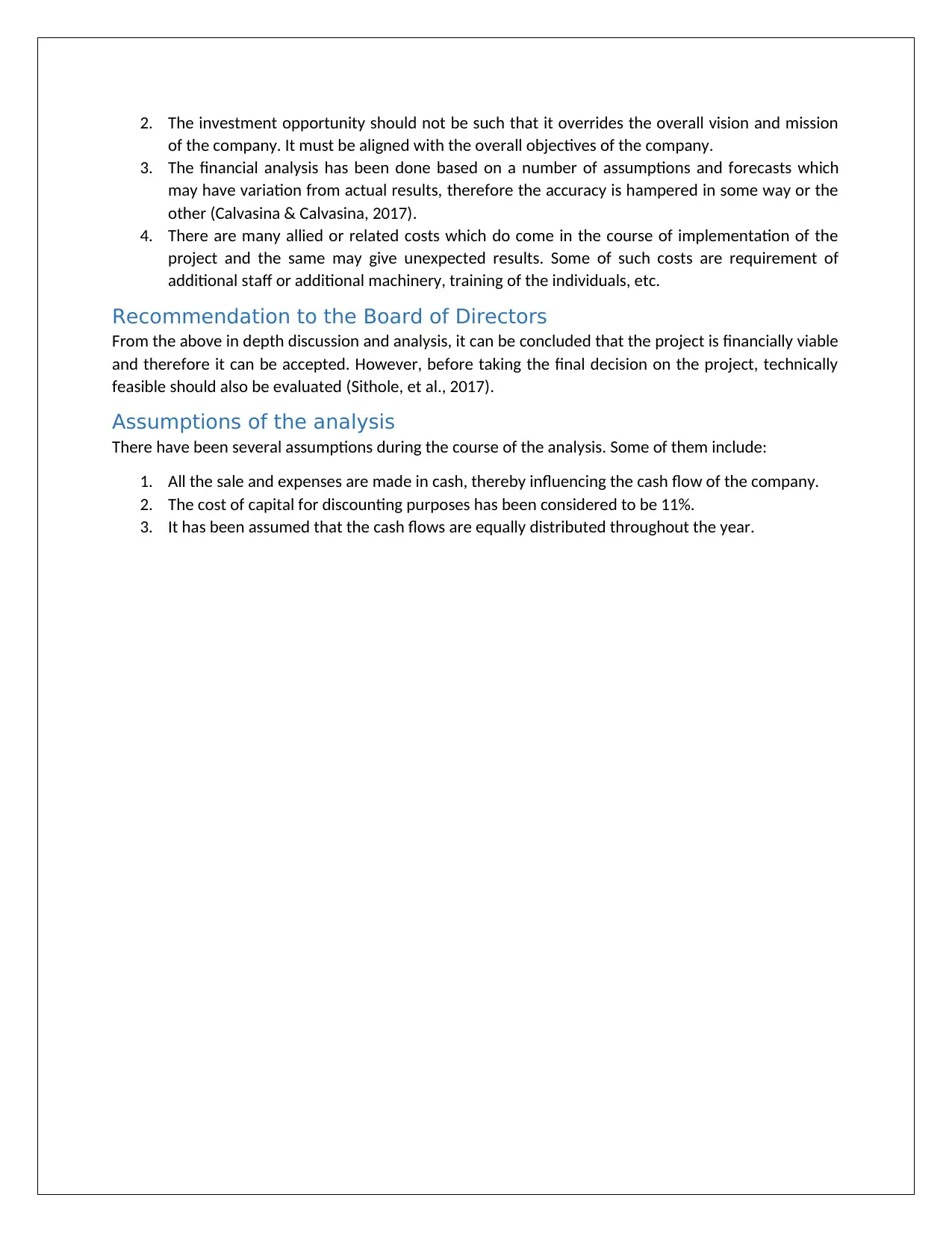
2. The investment opportunity should not be such that it overrides the overall vision and mission
of the company. It must be aligned with the overall objectives of the company.
3. The financial analysis has been done based on a number of assumptions and forecasts which
may have variation from actual results, therefore the accuracy is hampered in some way or the
other (Calvasina & Calvasina, 2017).
4. There are many allied or related costs which do come in the course of implementation of the
project and the same may give unexpected results. Some of such costs are requirement of
additional staff or additional machinery, training of the individuals, etc.
Recommendation to the Board of Directors
From the above in depth discussion and analysis, it can be concluded that the project is financially viable
and therefore it can be accepted. However, before taking the final decision on the project, technically
feasible should also be evaluated (Sithole, et al., 2017).
Assumptions of the analysis
There have been several assumptions during the course of the analysis. Some of them include:
1. All the sale and expenses are made in cash, thereby influencing the cash flow of the company.
2. The cost of capital for discounting purposes has been considered to be 11%.
3. It has been assumed that the cash flows are equally distributed throughout the year.
of the company. It must be aligned with the overall objectives of the company.
3. The financial analysis has been done based on a number of assumptions and forecasts which
may have variation from actual results, therefore the accuracy is hampered in some way or the
other (Calvasina & Calvasina, 2017).
4. There are many allied or related costs which do come in the course of implementation of the
project and the same may give unexpected results. Some of such costs are requirement of
additional staff or additional machinery, training of the individuals, etc.
Recommendation to the Board of Directors
From the above in depth discussion and analysis, it can be concluded that the project is financially viable
and therefore it can be accepted. However, before taking the final decision on the project, technically
feasible should also be evaluated (Sithole, et al., 2017).
Assumptions of the analysis
There have been several assumptions during the course of the analysis. Some of them include:
1. All the sale and expenses are made in cash, thereby influencing the cash flow of the company.
2. The cost of capital for discounting purposes has been considered to be 11%.
3. It has been assumed that the cash flows are equally distributed throughout the year.
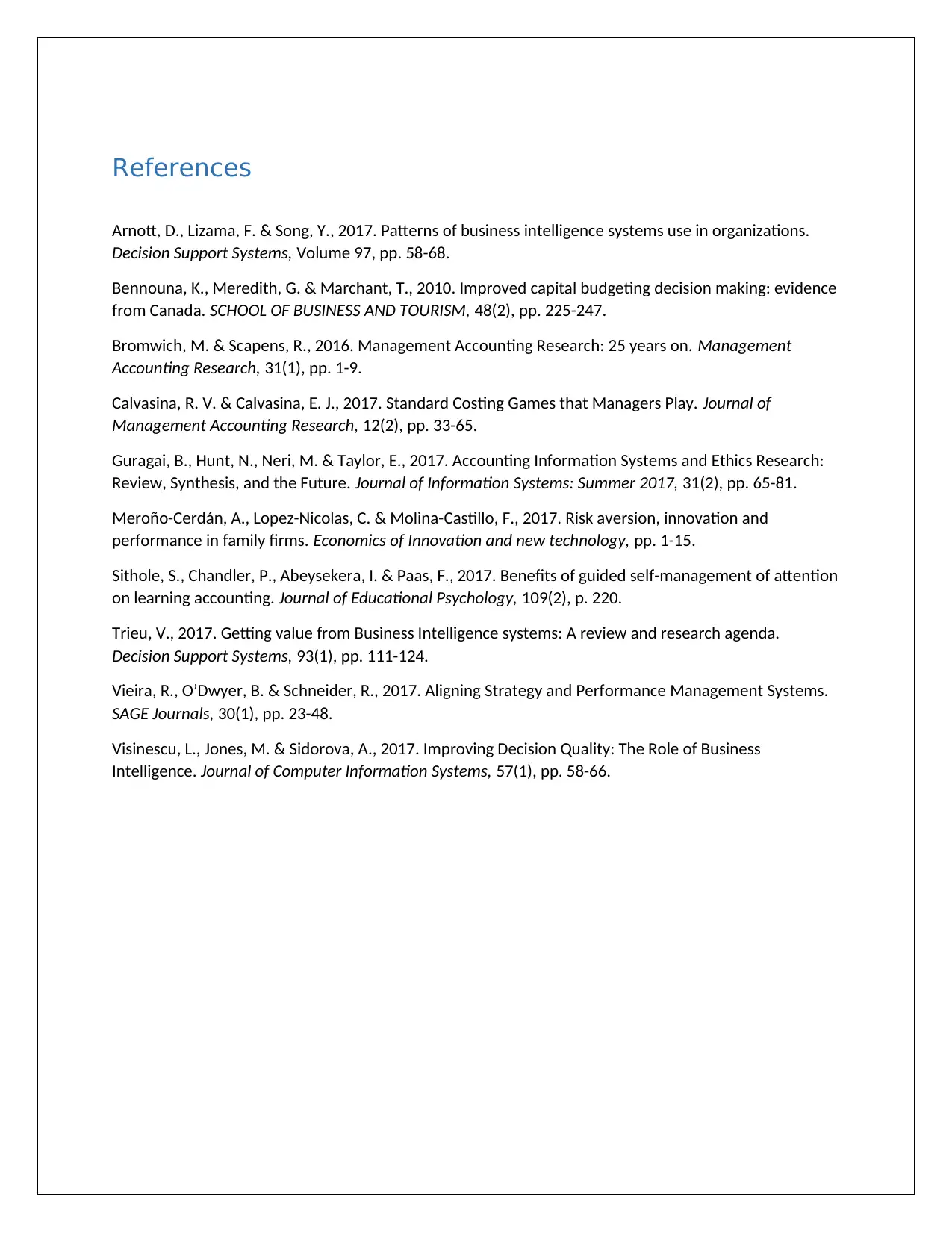
References
Arnott, D., Lizama, F. & Song, Y., 2017. Patterns of business intelligence systems use in organizations.
Decision Support Systems, Volume 97, pp. 58-68.
Bennouna, K., Meredith, G. & Marchant, T., 2010. Improved capital budgeting decision making: evidence
from Canada. SCHOOL OF BUSINESS AND TOURISM, 48(2), pp. 225-247.
Bromwich, M. & Scapens, R., 2016. Management Accounting Research: 25 years on. Management
Accounting Research, 31(1), pp. 1-9.
Calvasina, R. V. & Calvasina, E. J., 2017. Standard Costing Games that Managers Play. Journal of
Management Accounting Research, 12(2), pp. 33-65.
Guragai, B., Hunt, N., Neri, M. & Taylor, E., 2017. Accounting Information Systems and Ethics Research:
Review, Synthesis, and the Future. Journal of Information Systems: Summer 2017, 31(2), pp. 65-81.
Meroño-Cerdán, A., Lopez-Nicolas, C. & Molina-Castillo, F., 2017. Risk aversion, innovation and
performance in family firms. Economics of Innovation and new technology, pp. 1-15.
Sithole, S., Chandler, P., Abeysekera, I. & Paas, F., 2017. Benefits of guided self-management of attention
on learning accounting. Journal of Educational Psychology, 109(2), p. 220.
Trieu, V., 2017. Getting value from Business Intelligence systems: A review and research agenda.
Decision Support Systems, 93(1), pp. 111-124.
Vieira, R., O’Dwyer, B. & Schneider, R., 2017. Aligning Strategy and Performance Management Systems.
SAGE Journals, 30(1), pp. 23-48.
Visinescu, L., Jones, M. & Sidorova, A., 2017. Improving Decision Quality: The Role of Business
Intelligence. Journal of Computer Information Systems, 57(1), pp. 58-66.
Arnott, D., Lizama, F. & Song, Y., 2017. Patterns of business intelligence systems use in organizations.
Decision Support Systems, Volume 97, pp. 58-68.
Bennouna, K., Meredith, G. & Marchant, T., 2010. Improved capital budgeting decision making: evidence
from Canada. SCHOOL OF BUSINESS AND TOURISM, 48(2), pp. 225-247.
Bromwich, M. & Scapens, R., 2016. Management Accounting Research: 25 years on. Management
Accounting Research, 31(1), pp. 1-9.
Calvasina, R. V. & Calvasina, E. J., 2017. Standard Costing Games that Managers Play. Journal of
Management Accounting Research, 12(2), pp. 33-65.
Guragai, B., Hunt, N., Neri, M. & Taylor, E., 2017. Accounting Information Systems and Ethics Research:
Review, Synthesis, and the Future. Journal of Information Systems: Summer 2017, 31(2), pp. 65-81.
Meroño-Cerdán, A., Lopez-Nicolas, C. & Molina-Castillo, F., 2017. Risk aversion, innovation and
performance in family firms. Economics of Innovation and new technology, pp. 1-15.
Sithole, S., Chandler, P., Abeysekera, I. & Paas, F., 2017. Benefits of guided self-management of attention
on learning accounting. Journal of Educational Psychology, 109(2), p. 220.
Trieu, V., 2017. Getting value from Business Intelligence systems: A review and research agenda.
Decision Support Systems, 93(1), pp. 111-124.
Vieira, R., O’Dwyer, B. & Schneider, R., 2017. Aligning Strategy and Performance Management Systems.
SAGE Journals, 30(1), pp. 23-48.
Visinescu, L., Jones, M. & Sidorova, A., 2017. Improving Decision Quality: The Role of Business
Intelligence. Journal of Computer Information Systems, 57(1), pp. 58-66.
⊘ This is a preview!⊘
Do you want full access?
Subscribe today to unlock all pages.

Trusted by 1+ million students worldwide
1 out of 6
Related Documents
Your All-in-One AI-Powered Toolkit for Academic Success.
+13062052269
info@desklib.com
Available 24*7 on WhatsApp / Email
![[object Object]](/_next/static/media/star-bottom.7253800d.svg)
Unlock your academic potential
Copyright © 2020–2025 A2Z Services. All Rights Reserved. Developed and managed by ZUCOL.





